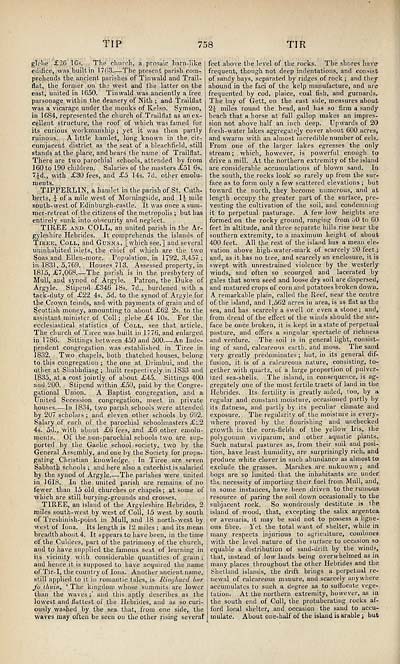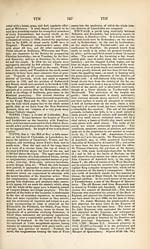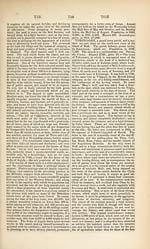Topographical, statistical, and historical gazetteer of Scotland > Volume 2
(778) Page 758
Download files
Complete book:
Individual page:
Thumbnail gallery: Grid view | List view

TIP
758
TIR
glebe £26 16s. The church,, a prosaic barn-like
edifice, was built in 1763. — The present parish com-
prehends the ancient parishes of Tinwald and Trail-
flat, the former on the west and the latter on the
east, united in 1650. Tinwald was anciently a free
parsonage within the deanery of Nith ; and Trailflat
was a vicarage under the monks of Kelso. Symson,
in 1684, represented the church of Trailflat as an ex-
cellent structure, the roof of which was famed for
its curious workmanship ; yet it was then partly
ruinous. A little hamlet, long known in the cir-
cumjacent district as the seat of a bleachfield, still
stands at the place, and bears the name of Trailflat.
There are two parochial schools, attended by from
160 to 190 children. Salaries of the masters £51 6s.
7£d., with £30 fees, and £5 14s. 7d. other emolu-
ments.
TIPPERLIN, a hamlet in the parish of St. Cuth-
berts, i of a mile west of Morningside, and 1^ mile
south-west of Edinburgh-castle. It was once a sum-
mer-retreat of the citizens of the metropolis ; but has
entirely sunk into obscurity and neglect.
TIREE and COLL, an united parish in the Ar-
gyleshire Hebrides. It comprehends the islands of
Tieee, Con,, and Gunna, [which see,] and several
uninhabited islets, the chief of which are the two
Soas and Ellen-more. Population, in 1792, 3,457 ;
in 1831, 5,769. Houses 713. Assessed property, in
1815, £7,068 The parish is in the presbytery of
Mull, and synod of Argyle. Patron, the Duke of
Argyle. Stipend £346 18s. 7d., burdened with a
tack-duty of £22 4s. 5d. to the synod of Argyle for
the Crown tenuis, and with payments of grain and of
Scottish money, amounting to about £62 2s. to the
assistant minister of Coll ; glebe £4 10s. For the
ecclesiastical statistics of Coll, see that article.
The church of Tiree was built in 1776, and enlarged
in 1786. Sittings between 450 and 500 An Inde-
pendent congregation was established in Tiree in
1832. Two chapels, both thatched houses, belong
to this congregation ; the one at Drimbui, and the
other at Sliabhdiasg ; built respectively in 1833 and
1835, at a cost jointly of about £45. Sittings 400
and 200. Stipend within £50, paid by the Congre-
gational Union. A Baptist congregation, and a
United Secession congregation, meet in private
houses. — In 1834, two parish schools were attended
by 207 scholars ; and eleven other schools by 692.
Salary of each of the parochial schoolmasters £22
4s. 5d., with about £6 fees, and £6 other emolu-
ments. Of the non-parochial schools two are sup-
ported by the Gaelic school society, two by the
General Assembly, and one by the Society for propa-
gating Christian knowledge. In Tiree are seven
Sabbath schools ; and here also a catechist is salaried
by the synod of Argyle. — The parishes were united
in 1618. In the united parish are remains of no
fewer than 15 old churches or chapels ; at some of
which are still burying-grounds and crosses.
TIREE, an island of the Argyleshire Hebrides, 2
miles south-west by west of Coll, 15 west by south
of Treshinish-point in Mull, and 18 north-west by
west of lona. Its length is 12 miles ; and its mean
breadth about 4. It appears to have been, in the time
of the Culdees, part of the patrimony of the church,
and to have supplied the famous seat of learning in
its vicinity with considerable quantities of grain;
and hence it is supposed to have acquired the name
of Tir-I, the country of lona. Another ancient name,
still applied to it in romantic tales, is Riayhacd bur
fo ihuin, ' The kingdom whose summits are lower
than the waves ;' and this aptly describes as the
lowest and flattest of the Hebrides, and as so curi-
ously washed by the sea that, from one side, the
waves may often be seen on the other rising several
feet above the level of the rocks. The shores hare
frequent, though not deep indentations, and consist
of sandy bays, separated by ridges of rock; and they
abound in the faci of the kelp manufacture, and are
frequented by cod, plaice, coal fish, and gurnards.
The bay of Gett, on the east side, measures about
2J miles round the head, and has so firm a sandy
beach that a horse at full gallop makes an impres-
sion not above half an inch deep. Upwards of 20
fresh-water lakes aggregately cover about 600 acres,
and swarm with an almost incredible number of eels.
From one of the larger lakes egresses the only
stream ; which, however, is powerful enough to
drive a mill. At the northern extremity of the island
are considerable accumulations of blown sand. In
the south, the rocks look so rarely up from the sur-
face as to form only a few scattered elevations ; but
toward the north, they become numerous, and at
length occupy the greater part of the surface, pre-
venting the cultivation of the soil, and condemning
it to perpetual pasturage. A few low heights are
formed on the rocky ground, ranging from oO to 60
feet in altitude, and three separate hills rise near the
southern extremity, to a maximum height of about
400 feet. All the rest of the island has a mean ele-
vation above bigh-water-mark of scarcely 20 feet ;
and, as it has no tree, and scarcely an enclosure, it is
swept with unrestrained violence by the westerly
winds, and often so scourged and lacerated by
gales that sown seed and loose dry soil are dispersed,
and matured crops of corn and potatoes broken down.
A remarkable plain, called the Reef, near the centre
of the island, and 1,562 acres in area, is as flat as the
sea, and has scarcely a swell or even a stone ; and,
from dread of the effect of the winds should the sur-
face be once broken, it is kept in a state of perpetual
pasture, and offers a singular spectacle of richness
and verdure. The soil is in general light, consist-
ing of sand, calcareous earth, and moss. The sand
very greatly predominates ; but, in its general dif-
fusion, it is of a calcareous nature, consisting, to-
gether with quartz, of a large proportion of pulver-
ized sea-shells. The island, in consequence, is ag-
gregately one of the most fertile tracts of land in the
Hebrides. Its fertility is greatly aided, too, by a
regular and constant moisture, occasioned partly by
its flatness, and partly by its peculiar climate and
exposure. The regularity of the moisture is every-
where proved by the flourishing and unchecked
growth in the corn-fields of the yellow Iris, the
polygonum viviparum, and other aquatic plants.
Such natural pastures as, from their soil and posi-
tion, have least humidity, are surprisingly rich, and
produce white clover in such abundance as almost to
exclude the grasses. Marshes are unknown ; and
bogs are so limited that the inhabitants are under
the necessity of importing their fuel from Mull, and,
in some instances, have been driven to the ruinous
resource of paring the soil down occasionally to the
subjacent rock. So wondrously destitute is the
island of wood, that, excepting the salix argentea
or avenaria, it may be said not to possess a ligne-
ous fibre. Yet the total want of shelter, while in
many respects injurious to agriculture, combines
with the level nature of the surface to occasion so
equable a distribution of sand-drift by the winds,
that, instead of low lands being overwhelmed as in
many places throughout the other Hebrides and the
Shetland islands, the drift brings a perpetual re-
newal of calcareous manure, and scarcely anywhere
accumulates to such a degree as to suffocate vege-
tation. At the northern extremity, however, as in
the south end of Coll, the protuberating rocks af-
ford local shelter, and occasion the sand to accu-
mulate. About one-half of the island is arable ; but
758
TIR
glebe £26 16s. The church,, a prosaic barn-like
edifice, was built in 1763. — The present parish com-
prehends the ancient parishes of Tinwald and Trail-
flat, the former on the west and the latter on the
east, united in 1650. Tinwald was anciently a free
parsonage within the deanery of Nith ; and Trailflat
was a vicarage under the monks of Kelso. Symson,
in 1684, represented the church of Trailflat as an ex-
cellent structure, the roof of which was famed for
its curious workmanship ; yet it was then partly
ruinous. A little hamlet, long known in the cir-
cumjacent district as the seat of a bleachfield, still
stands at the place, and bears the name of Trailflat.
There are two parochial schools, attended by from
160 to 190 children. Salaries of the masters £51 6s.
7£d., with £30 fees, and £5 14s. 7d. other emolu-
ments.
TIPPERLIN, a hamlet in the parish of St. Cuth-
berts, i of a mile west of Morningside, and 1^ mile
south-west of Edinburgh-castle. It was once a sum-
mer-retreat of the citizens of the metropolis ; but has
entirely sunk into obscurity and neglect.
TIREE and COLL, an united parish in the Ar-
gyleshire Hebrides. It comprehends the islands of
Tieee, Con,, and Gunna, [which see,] and several
uninhabited islets, the chief of which are the two
Soas and Ellen-more. Population, in 1792, 3,457 ;
in 1831, 5,769. Houses 713. Assessed property, in
1815, £7,068 The parish is in the presbytery of
Mull, and synod of Argyle. Patron, the Duke of
Argyle. Stipend £346 18s. 7d., burdened with a
tack-duty of £22 4s. 5d. to the synod of Argyle for
the Crown tenuis, and with payments of grain and of
Scottish money, amounting to about £62 2s. to the
assistant minister of Coll ; glebe £4 10s. For the
ecclesiastical statistics of Coll, see that article.
The church of Tiree was built in 1776, and enlarged
in 1786. Sittings between 450 and 500 An Inde-
pendent congregation was established in Tiree in
1832. Two chapels, both thatched houses, belong
to this congregation ; the one at Drimbui, and the
other at Sliabhdiasg ; built respectively in 1833 and
1835, at a cost jointly of about £45. Sittings 400
and 200. Stipend within £50, paid by the Congre-
gational Union. A Baptist congregation, and a
United Secession congregation, meet in private
houses. — In 1834, two parish schools were attended
by 207 scholars ; and eleven other schools by 692.
Salary of each of the parochial schoolmasters £22
4s. 5d., with about £6 fees, and £6 other emolu-
ments. Of the non-parochial schools two are sup-
ported by the Gaelic school society, two by the
General Assembly, and one by the Society for propa-
gating Christian knowledge. In Tiree are seven
Sabbath schools ; and here also a catechist is salaried
by the synod of Argyle. — The parishes were united
in 1618. In the united parish are remains of no
fewer than 15 old churches or chapels ; at some of
which are still burying-grounds and crosses.
TIREE, an island of the Argyleshire Hebrides, 2
miles south-west by west of Coll, 15 west by south
of Treshinish-point in Mull, and 18 north-west by
west of lona. Its length is 12 miles ; and its mean
breadth about 4. It appears to have been, in the time
of the Culdees, part of the patrimony of the church,
and to have supplied the famous seat of learning in
its vicinity with considerable quantities of grain;
and hence it is supposed to have acquired the name
of Tir-I, the country of lona. Another ancient name,
still applied to it in romantic tales, is Riayhacd bur
fo ihuin, ' The kingdom whose summits are lower
than the waves ;' and this aptly describes as the
lowest and flattest of the Hebrides, and as so curi-
ously washed by the sea that, from one side, the
waves may often be seen on the other rising several
feet above the level of the rocks. The shores hare
frequent, though not deep indentations, and consist
of sandy bays, separated by ridges of rock; and they
abound in the faci of the kelp manufacture, and are
frequented by cod, plaice, coal fish, and gurnards.
The bay of Gett, on the east side, measures about
2J miles round the head, and has so firm a sandy
beach that a horse at full gallop makes an impres-
sion not above half an inch deep. Upwards of 20
fresh-water lakes aggregately cover about 600 acres,
and swarm with an almost incredible number of eels.
From one of the larger lakes egresses the only
stream ; which, however, is powerful enough to
drive a mill. At the northern extremity of the island
are considerable accumulations of blown sand. In
the south, the rocks look so rarely up from the sur-
face as to form only a few scattered elevations ; but
toward the north, they become numerous, and at
length occupy the greater part of the surface, pre-
venting the cultivation of the soil, and condemning
it to perpetual pasturage. A few low heights are
formed on the rocky ground, ranging from oO to 60
feet in altitude, and three separate hills rise near the
southern extremity, to a maximum height of about
400 feet. All the rest of the island has a mean ele-
vation above bigh-water-mark of scarcely 20 feet ;
and, as it has no tree, and scarcely an enclosure, it is
swept with unrestrained violence by the westerly
winds, and often so scourged and lacerated by
gales that sown seed and loose dry soil are dispersed,
and matured crops of corn and potatoes broken down.
A remarkable plain, called the Reef, near the centre
of the island, and 1,562 acres in area, is as flat as the
sea, and has scarcely a swell or even a stone ; and,
from dread of the effect of the winds should the sur-
face be once broken, it is kept in a state of perpetual
pasture, and offers a singular spectacle of richness
and verdure. The soil is in general light, consist-
ing of sand, calcareous earth, and moss. The sand
very greatly predominates ; but, in its general dif-
fusion, it is of a calcareous nature, consisting, to-
gether with quartz, of a large proportion of pulver-
ized sea-shells. The island, in consequence, is ag-
gregately one of the most fertile tracts of land in the
Hebrides. Its fertility is greatly aided, too, by a
regular and constant moisture, occasioned partly by
its flatness, and partly by its peculiar climate and
exposure. The regularity of the moisture is every-
where proved by the flourishing and unchecked
growth in the corn-fields of the yellow Iris, the
polygonum viviparum, and other aquatic plants.
Such natural pastures as, from their soil and posi-
tion, have least humidity, are surprisingly rich, and
produce white clover in such abundance as almost to
exclude the grasses. Marshes are unknown ; and
bogs are so limited that the inhabitants are under
the necessity of importing their fuel from Mull, and,
in some instances, have been driven to the ruinous
resource of paring the soil down occasionally to the
subjacent rock. So wondrously destitute is the
island of wood, that, excepting the salix argentea
or avenaria, it may be said not to possess a ligne-
ous fibre. Yet the total want of shelter, while in
many respects injurious to agriculture, combines
with the level nature of the surface to occasion so
equable a distribution of sand-drift by the winds,
that, instead of low lands being overwhelmed as in
many places throughout the other Hebrides and the
Shetland islands, the drift brings a perpetual re-
newal of calcareous manure, and scarcely anywhere
accumulates to such a degree as to suffocate vege-
tation. At the northern extremity, however, as in
the south end of Coll, the protuberating rocks af-
ford local shelter, and occasion the sand to accu-
mulate. About one-half of the island is arable ; but
Set display mode to: Large image | Transcription
Images and transcriptions on this page, including medium image downloads, may be used under the Creative Commons Attribution 4.0 International Licence unless otherwise stated. ![]()
| Gazetteers of Scotland, 1803-1901 > Topographical, statistical, and historical gazetteer of Scotland > Volume 2 > (778) Page 758 |
|---|
| Permanent URL | https://digital.nls.uk/97503299 |
|---|
| Description | Volume second. I-Z. |
|---|---|
| Attribution and copyright: |
|

